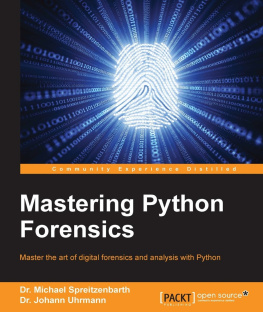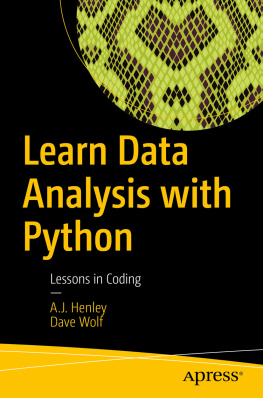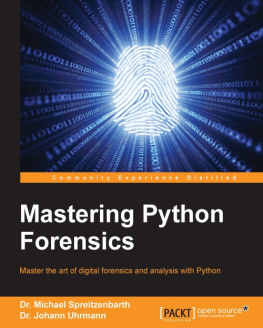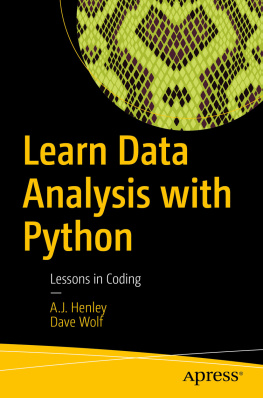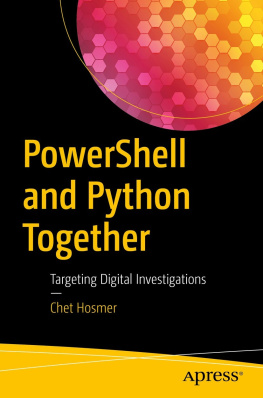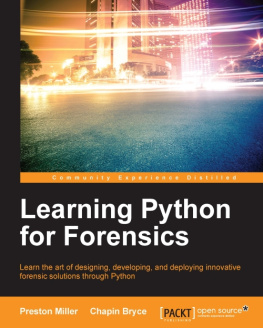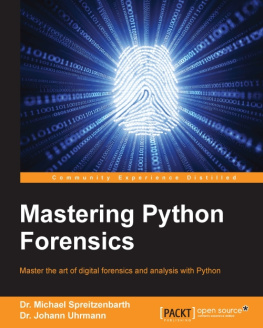Dr. Michael Spreitzenbarth - Mastering Python Forensics
Here you can read online Dr. Michael Spreitzenbarth - Mastering Python Forensics full text of the book (entire story) in english for free. Download pdf and epub, get meaning, cover and reviews about this ebook. year: 2015, publisher: Packt Publishing, genre: Computer. Description of the work, (preface) as well as reviews are available. Best literature library LitArk.com created for fans of good reading and offers a wide selection of genres:
Romance novel
Science fiction
Adventure
Detective
Science
History
Home and family
Prose
Art
Politics
Computer
Non-fiction
Religion
Business
Children
Humor
Choose a favorite category and find really read worthwhile books. Enjoy immersion in the world of imagination, feel the emotions of the characters or learn something new for yourself, make an fascinating discovery.
- Book:Mastering Python Forensics
- Author:
- Publisher:Packt Publishing
- Genre:
- Year:2015
- Rating:5 / 5
- Favourites:Add to favourites
- Your mark:
Mastering Python Forensics: summary, description and annotation
We offer to read an annotation, description, summary or preface (depends on what the author of the book "Mastering Python Forensics" wrote himself). If you haven't found the necessary information about the book — write in the comments, we will try to find it.
Abstract: Master the art of digital forensics and analysis with Python About This Book Learn to perform forensic analysis and investigations with the help of Python, and gain an advanced understanding of the various Python libraries and frameworks Analyze Python scripts to extract metadata and investigate forensic artifacts The writers, Dr. Michael Spreitzenbarth and Dr. Johann Uhrmann, have used their experience to craft this hands-on guide to using Python for forensic analysis and investigations Who This Book Is For If you are a network security professional or forensics analyst who wants to gain a deeper understanding of performing forensic analysis with Python, then this book is for you. Some Python experience would be helpful. What You Will Learn Explore the forensic analysis of different platforms such as Windows, Android, and vSphere Semi-automatically reconstruct major parts of the system activity and time-line Leverage Python ctypes for protocol decoding Examine artifacts from mobile, Skype, and browsers Discover how to utilize Python to improve the focus of your analysis Investigate in volatile memory with the help of volatility on the Android and Linux platforms In Detail Digital forensic analysis is the process of examining and extracting data digitally and examining it. Python has the combination of power, expressiveness, and ease of use that makes it an essential complementary tool to the traditional, off-the-shelf digital forensic tools. This book will teach you how to perform forensic analysis and investigations by exploring the capabilities of various Python libraries. The book starts by explaining the building blocks of the Python programming language, especially ctypes in-depth, along with how to automate typical tasks in file system analysis, common correlation tasks to discover anomalies, as well as templates for investigations. Next, well show you cryptographic algorithms that can be used during forensic investigations to check for known files or to compare suspicious files with online services such as VirusTotal or Mobile-Sandbox. Moving on, youll learn how to sniff on the network, generate and analyze network flows, and perform log correlation with the help of Python scripts and tools. Youll get to know about the concepts of virtualization and how virtualization influences IT forensics, and youll discover how to perform forensic analysis of a jailbroken/rooted mobile device that is based on iOS or Android. Finally, the book t
Dr. Michael Spreitzenbarth: author's other books
Who wrote Mastering Python Forensics? Find out the surname, the name of the author of the book and a list of all author's works by series.

